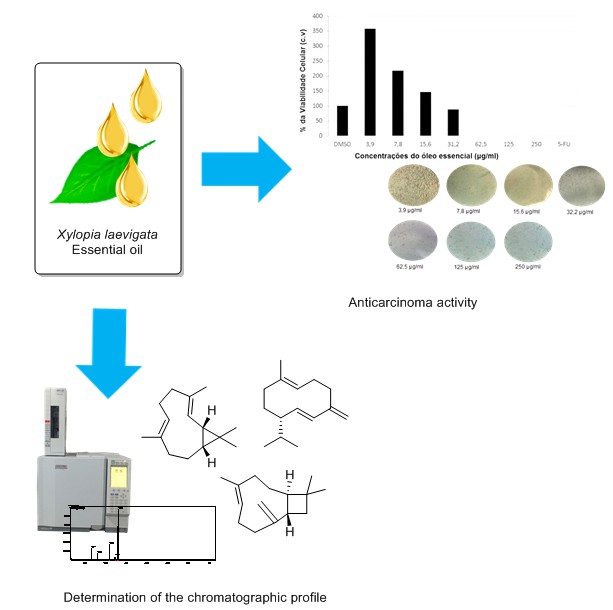Chemical constituents and cytotoxic potential of essential oil Xylopia laevigata in hepatocellular carcinoma cells - HepG2
DOI:
https://doi.org/10.70151/d1452f06Keywords:
cytotoxic potential, Natural Products, Essential Oils, Antitumor ActivityAbstract
The Xylopia laevigata (Mart.) R. E. Frie, known as pindaíba or meiu is a native plant of the Atlantic Forest and popularly applied as a medicinal plant in some regions of the country. The essential oil extracted from the leaves of this plant was characterized in order to determine their chemical composition and evaluated the cytotoxic potential of the essential oil, the front line HepG2 hepatocellular carcinoma (liver cancer). The essential oil was extracted by hydrodistillation and components identified by gas chromatography with FID detector and gas chromatography coupled to mass spectrometry. The major identified compounds were bicyclogermacrene, β-caryophyllene, Germacrene-D, spatulenol and α-amorfene. To assess cell viability was used XTT (2,3-Bis-(2-Methoxy-4-Nitro-5-Sulfophenyl)-2H-Tetrazolium-5-Carboxanilide), which checks the cellular redox potential. All concentrations 62.5 mg/ml to 250 mg/ml, the inhibition occurred in 100 % cells of hepatocellular carcinoma. These results direct the subsequent phytochemical studies to confirm their cytotoxic potential and their possible applications in antitumor activity.
Downloads
References
Adams RP (2007) Identification of essential oil components by gas chromatography/ mass spectrometry. Allured Publishing Corp.
Bagetta G, Morrone LA, Rombola L, Amantea D, Russo R, Berliochi L, Sakurada S, Sakurada T, Rotiroti D, Corasanti MT (2010) Neuropharmacology of the essential oil of bergamot. Fitoterapia. https://doi.org/10.1016/j.fitote.2010.01.013
Bakkali F, Averbeck S, Averbeck D, Idaomar, M (2008) Biological effects of essential oils – a review. Food Chem Toxicol. https://doi.org/10.1016/j.fct.2007.09.106
Câmara CAG, Pontes WJT, Oliveira JCS, Gondim MGC, Oliveira, JV, Schwartz MOE (2007) Atividade acaricida dos óleos essências de folhas e frutos de Xylopia sericea. Quim Nova. https://doi.org/10.1590/S0100-40422007000400015
Costa EV (2012) Essential oil from the leaves of Annona vepretorum: chemical composition and bioactivity. Nat Prod Commun. https://doi.org/10.1177%2F1934578X1200700240
Craveiro AA (1981) Óleos essenciais das plantas do Nordeste. Ed. UFC.
Edris AE (2007) Pharmaceutical and therapeutic potentials of essential oils and their individual volatile constituents: a review. Phytother Res. https://doi.org/10.1002/ptr.2072
Fechine IV, Navarro VR, Cunha EVL, Silva MS, Maia JGS, Barbosa-Filho JM (2002) Alkaloids and volatile constituents from Duguetia flagellaris. Biochem Syst Ecol. http://dx.doi.org/10.1016/S0305-1978(01)00090-4 GonzÁlez MC, Tormo J, Bermejo A, Zafra-Polo MC, Estornell E, Cortes D (1997) Rollimembrin, a novel Acetogenin Inibitor of Mammalian Mitochondrial Complex I. Bioorg Med Chem Lett. https://doi.org/10.1016/S0960-894X(97)00171-6
Harzallah HJ, Kouidhi B, Flamini G, Bakhrouf A, Mahjoub T (2011) Chemical compisition, antimicrobial potential against cariogenic bactéria and cytotoxic activity of Tunisian Nigella sativa essential oil and thymoquinime. Food Chem. https://doi.org/10.1016/j.foodchem.2011.05.117
Jaafari MR, Bavarsad N, Bazzaz BSF, Samiei A, Soroush D, Chorbani S, Heravi MML, Khamesipour A (2009) Effect of topical liposomes containing paromomycin sulfate in the course of Leishmania major infection in susceptible BALB/c mice. Antimicrob Agents Ch. https://doi.org/10.1128/AAC.01319-08
Lima LARS, Pimenta LPS, Boaventura MAD (2010) Acetogenins from Annona cornifolia and their antioxidant capacity. Food Chem. https://doi.org/10.1016/j.foodchem.2010.03.100
Mans, DRA, Rocha AB, Schwartsmann G (2000) Anti-cancer drug discovery and development in Brazil: targeted plant collection as a rational strategy to acquire candidate anti-cancer compounds. The Oncologist. https://doi.org/10.1634/theoncologist.5-3-185
Maas PJM, Kamer HMD, Junikka L, Mello-Silva RD, Rainer H (2001) Annonaceae from Central-eastern Brazil. Rodriguésia. https://doi.org/10.1590/2175-78602001528005
Maas P, Lobão A, Rainer H (2016) Annonaceae in Lista de Espécies da Flora do Brasil. Jardim Botânico do Rio de Janeiro.
Maia JGS, Andrade EHA, Da Silva ACM, Oliveira J, Carreira LMM, Araújo JS (2005) Leaf volatile oils from four Brazilian Xylopia species. Flavour Fragr J. https://doi.org/10.1002/ffj.1499
Maggio AM, Barone G, Bruno M, Duca D, Rosselli SJ (2005) Conformational analysis and DFT calculations of 8a-hydroxy-germacradiene-6,12-olide derivates. J Phys Org Chem. https://doi.org/10.1002/poc.976
Matsumoto RS, Ribeiro JPN, Takao LK (2010) Allelopathic potential of leaf extract of Annona glabra L. (Annonaceae). Acta Bot Bras. https://doi.org/10.1590/S0102-33062010000300005
Mendes SS, Bomfim RR, Jesus HCR, Alves PB, Blank AF, Estevam CS, Antoniolli AR, Thomazzi SM (2010) Evaluation of the analgesic and anti-inflammatory effects of the essential oil of Lippia gracilis leaves. J Ethnopharmacol. https://doi.org/10.1016/j.jep.2010.04.005
Neves A, Rosa S, Gonçalves J, Rufino A, Judas F, Salgueiro L, Lopes MC, Cavaleiro C, Mendes AF (2010) Screening of five essential oils for identification of potential inhibitors of IL-1-induced NFκB activation and NO production in human chondrocytes: characterization of the inhibitory activity of α-pinene. Planta Med. https://doi.org/10.1055/s-0029-1186085
Pisco L, Kordian M, Peseke Feist H, Michalik D, Estrada E, Carvalho J, Hamilton G, Rando D, Quincoces J (2006) Synthesis of compounds with antiproliferative activity as analogues of prenylated natural products existing in Brazilian propolis. Eur J Med Chem. https://doi.org/10.1016/j.ejmech.2005.10.020
Queiroz, JCC, Antoniolli ÂR, Quintans LJ, Brito RG, Barreto RSS, Costa EV, Silva TB, Prata APN, Lucca JRW, Almeida JRGS, Lima J, Quintans JSS (2014) Evaluation of the Anti-Inflammatory and AntinociceptiveEffects of the Essential Oil from Leaves of Xylopia laevigata in Experimental Models. Sci World J. http://dx.doi.org/10.1155/2014/816450
Quintans JS, Soares BM, Ferraz RP, Oliveira AC, Da Silva TB, Menezes LR, Sampaio MF, Prata AP, Moraes MO, Pessoa C, Antoniolli AR, Costa EV, Bezerra DP (2013) Chemical Constituents and Anticancer Effects of the Essential Oil from Leaves of Xylopia laevigata. Planta Med. http://dx.doi.org/10.1055/s-0032-1328091
RABÊLO SV (2014) Revisão de alcaloides do gênero Annona, estudo fitoquímico e avaliação da atividade biológica de atemoia (Annona cherimola x Annona squamosa). 234p. Dissertação (Mestrado em Recursos Naturais do Semiárido), Universidade Federal do Vale do São Francisco, Campus Petrolina, Petrolina-PE.

Downloads
Published
Issue
Section
License

This work is licensed under a Creative Commons Attribution-NonCommercial-NoDerivatives 4.0 International License.

